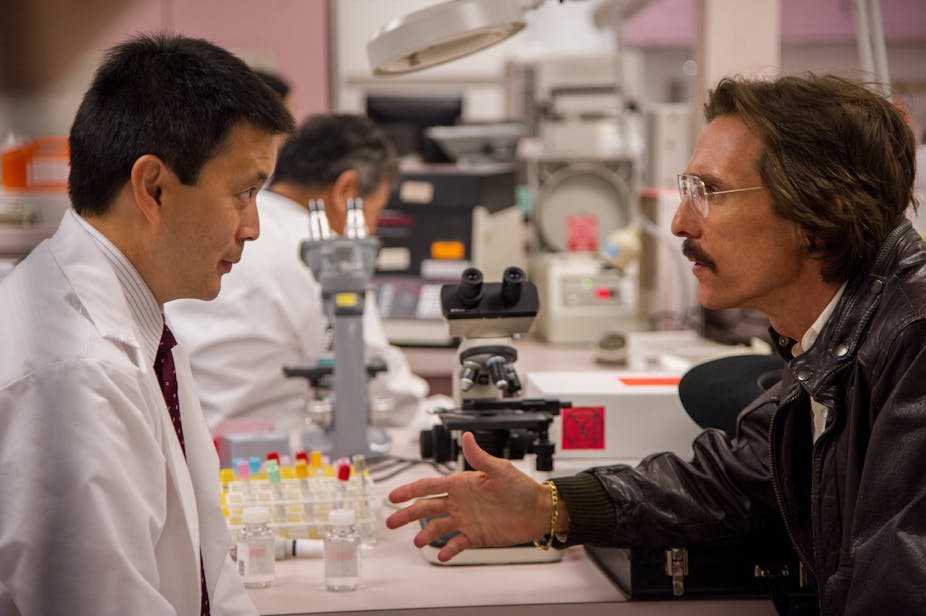This article contains spoilers.
In the award-winning movie The Dallas Buyers Club, Matthew McConaughey plays the role of Ron Woodroof, a real-life Texas cowboy who was diagnosed with HIV/AIDS in 1985.
HIV/AIDS is now a chronic but manageable illness, at least for people in high-income countries who have access to highly effective antiretroviral drugs, but at the time of Ron’s diagnosis, a positive HIV test was largely a death sentence.
The first effective treatment for AIDS, zidovudine (AZT), was still in development in 1985. AZT wouldn’t be approved by the United States Food and Drug Administration (FDA) until 1987, so access was largely restricted to patients enrolled in clinical trials.
During the early years of the HIV/AIDS epidemic, the disease was largely seen as primarily affecting gay men, prostitutes and drug users. Discrimination against people living with HIV/AIDS was common: they were routinely and legally kicked out of their homes, expelled from their classrooms, and fired from their jobs.
Patients even faced discrimination at the hands of healthcare professionals. Even as this public health crisis unfolded, many doctors and nurses openly proclaimed they would not be going anywhere near a patient with AIDS because of the personal risk and because of their obligations to protect their own family. Small wonder, then, that most people living with HIV/AIDS in the mid-1980s died within a few months of receiving a diagnosis.
Ron’s story
Ron Woodroof would have been just another statistic: his disease was relatively advanced at the time diagnosis, he was precluded from enrolling in a clinical trial of AZT for safety reasons, and he was largely abandoned by his friend and family because of the shame of having a “gay disease”. But he chose to fight rather than succumb to a then untreatable illness.
Thus began Ron’s prolonged struggle, which ended in 1992 when he died from an AIDS-related illness (nearly seven years after doctors gave him but a few weeks to live).
Ron began to self-treat using unapproved and illicitly obtained antiviral medications. Soon, he and his colleagues are routinely travelling to Mexico, Japan, Israel and the Netherlands to purchase antiviral drugs and treatments that were not approved or available for use in the United States. They begin providing these drugs to those living with HIV/AIDS – primarily members of stigmatised communities like gay men and drug users – via the commercial operation that gives the movie its name, the Dallas Buyers Club.
The activists who changed history
Ron Woodroof also (albeit unsuccessfully) took the FDA to court to force them to allow the importation of the experimental HIV inhibitor Peptide T from Denmark. In doing so, he became part of a larger movement in which community-based organisations and activists began to set their own agenda for biomedical research and treatment.
Outraged by federal regulations and policies that slow the development, testing and distribution of new drugs to treat HIV/AIDS, for instance, activists in New York City, San Francisco and elsewhere established groups such as the Gay Men’s Health Crisis, Project Inform, AIDS Coalition to Unleash Power (ACT UP) and the Treatment Action Group. Like Ron, these organisations helped change the way clinicians, researchers, drug companies, and local, state and national governments addressed the HIV/AIDS epidemic.
In the documentary How to Survive a Plague, nominated for best documentary at last year’s Oscars, we see how ACT-UP mobilised a national demonstration at the FDA in 11 October, 1988. On that day, more than 1,500 activists from around the world surrounded and effectively shut down FDA headquarters. Shortly thereafter, in consultation with ACT UP and like-minded organisations, the FDA instituted new policies to speed up the testing, approval and distribution of HIV/AIDS drugs, including the first program to provide pre-approval access to new drugs for people failing AZT treatment.
Similar demonstrations at the US National Institutes of Health lead to other significant changes in how clinical trials are designed and conducted. This included the formation of groups in which members from afflicted communities participated as full members of trial committees and protocol teams.
Woodroof’s legacy
What these two films, the semi-fictional Dallas Buyers Club and the documentary How to Survive a Plague, expertly show is how a single individual or a small group of dedicated activists can have a significant and long-lasting impact on public policy even in the face of private apathy or open hostility.
At the start of the HIV/AIDS epidemic, public response to the disease was tepid at best. Federal funding for public health had been repeatedly cut, effectively preventing agencies such as the US Centers for Disease Control and Prevention from responding to the emerging threat. Public health officials and politicians also seemed largely unconcerned about the disease, so long as it largely affected marginalised members of society.
All that changed thanks to the efforts of Ron Woodroof and those like him. These people both highlighted injustice and prejudice against people with HIV/AIDS, and demanded increased government resources for fighting the disease. Since then activists and advocacy groups have become an increasingly important part of biomedical research and clinical practice, not just for HIV/AIDS but also for diseases such as breast cancer, Alzheimer’s and autism.
There is still a long way to go. Community advocates and activists are not always fully empowered, equal members of research and treatment teams, and more wealthy and connected organisations can often dictate the topic of conversation. But public health research and practice is vastly improved from the highly politicised approaches of the past.

